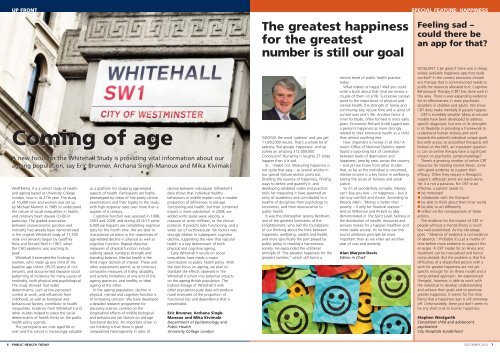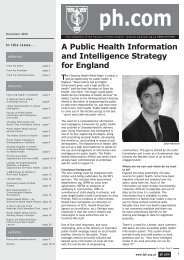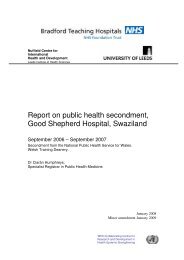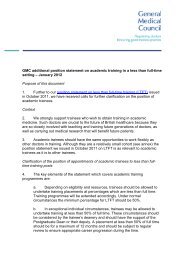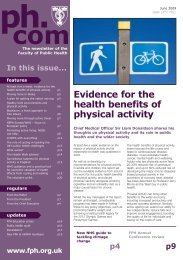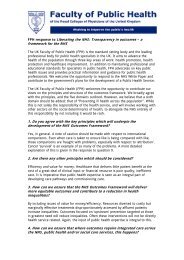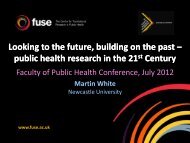December Edition â Happiness - UK Faculty of Public Health
December Edition â Happiness - UK Faculty of Public Health
December Edition â Happiness - UK Faculty of Public Health
- No tags were found...
Create successful ePaper yourself
Turn your PDF publications into a flip-book with our unique Google optimized e-Paper software.
UP FRONTThe greatest happinessfor the greatestnumber is still our goalSPECIAL FEATURE: HAPPINESSFeeling sad –could there bean app for that?Coming <strong>of</strong> ageA new focus for the Whitehall Study is providing vital information about ourageing population, say Eric Brunner, Archana Singh-Manoux and Mika KivimakiWHITEHALL II is a cohort study <strong>of</strong> healthand ageing based at University CollegeLondon, now in its 27th year. The study<strong>of</strong> 10,308 men and women was set upby Michael Marmot in 1985 to understandthe nature <strong>of</strong> social inequalities in health,and coronary heart disease (CHD) inparticular. The graded associationbetween socioeconomic position andmortality had already been demonstratedin the original Whitehall study <strong>of</strong> 17,500male civil servants begun by Ge<strong>of</strong>freyRose and Donald Reid in 1967, whenthe CHD epidemic was reaching itspeak.Whitehall II extended the findings towomen, who made up one third <strong>of</strong> thebaseline age cohort (35-55 years) <strong>of</strong> civilservants, and documented stepwise socialpatterning <strong>of</strong> incidence for many causes <strong>of</strong>morbidity, both physical and psychological.The study showed that widerdeterminants, such as low perceivedcontrol at work, and influences fromchildhood, as well as biological andbehavioural factors, contribute to healthinequalities. Evidence from Whitehall II andother studies helped to place the socialdeterminants <strong>of</strong> health firmly on the publichealth policy agenda.The participants are now aged 60 orover and the cohort is increasingly valuableas a platform for studying age-relatedaspects <strong>of</strong> health. Participants are highlyphenotyped by virtue <strong>of</strong> five-yearly clinicalexaminations and their loyalty to the study,with high response rates over more than aquarter <strong>of</strong> a century.Cognitive function was assessed in 1998,2003 and 2008; and during 2012/13 some6,000 participants are completing cognitivetests for the fourth time. We are able tocharacterise variation in the trajectories <strong>of</strong>age-related decline in physical as well ascognitive function. Repeat objectivemeasures <strong>of</strong> physical function includewalking speed, handgrip strength andstanding balance. Mental health is thethird major domain <strong>of</strong> interest. These andother assessments permit us to constructcomposite measures <strong>of</strong> frailty, disability,and activity limitations at one end <strong>of</strong> theageing spectrum, and healthy or idealageing at the other.In the ageing population, decline inphysical, mental and cognitive function is<strong>of</strong> increasing concern. We have developeda detailed research programme fordiscovery science, centred on thelongitudinal effects <strong>of</strong> midlife biologicaland behavioural risk factors on old-agefunctional decline. An important driver inour thinking is that there is greatunexplained heterogeneity in rates <strong>of</strong>decline between individuals. Whitehall IIdata shows that individual healthybehaviours in midlife explain only a modestproportion <strong>of</strong> differences in old-agefunctioning and health, but their combinedimpact is more substantial. In 2008, weadded aortic pulse wave velocity, ameasure <strong>of</strong> aortic stiffness, to the clinicalprotocol. It predicts later functioning, and awider set <strong>of</strong> cardiovascular risk factors wasstrongly related to subsequent cognitivedecline, supporting the view that vascularhealth is a key determinant <strong>of</strong> bothphysical and cognitive ageing.Early Whitehall II results on socialinequalities have made a majorcontribution to public health policy. Withthe new focus on ageing, we plan totranslate the effects observed in theWhitehall II cohort into potential impactson the ageing British population. Theindirect linkage <strong>of</strong> Whitehall II withother population-scale data will producenovel estimates <strong>of</strong> the proportion <strong>of</strong>functional loss and dependence that ispreventable.Eric Brunner, Archana Singh-Manoux and Mika KivimakiDepartment <strong>of</strong> Epidemiology and<strong>Public</strong> <strong>Health</strong>University College LondonGOOGLE the word ‘sadness’ and you get11,600,000 results. That’s a whole lot <strong>of</strong>sadness. But google ‘happiness’ and upcomes an amazing 312,000,000.Conclusion? Humanity is roughly 27 timeshappier than it is sad.Er... maybe not. Measuring happiness isnot quite that easy – as several articles inour special feature section point out.Distilling the essence <strong>of</strong> happiness, findingways to define and quantify it, anddeveloping validated scales and practicaltools for measuring it have spawned anarmy <strong>of</strong> academics and contributed to aswathe <strong>of</strong> disciplines from psychology toeconomics, and from neuroscience topublic health.It was the philosopher Jeremy Bentham,one <strong>of</strong> the greatest luminaries <strong>of</strong> theEnlightenment, who laid the foundations<strong>of</strong> our thinking about the links betweenhappiness, wellbeing, wealth and health,and more specifically the part played bypublic policy in creating a harmonioussociety. He expounded the utilitarianprinciple <strong>of</strong> “the greatest happiness for thegreatest number,” which still forms acentral tenet <strong>of</strong> public health practicetoday.What makes us happy? Well you couldwrite a book about that (and we review acouple <strong>of</strong> them on p19). Successive surveyspoint to the importance <strong>of</strong> physical andmental health, the strength <strong>of</strong> family andcommunity ties, leisure time and a sense <strong>of</strong>control over one's life. Another factor isinner fortitude, <strong>of</strong>ten formed in one’s earlyyears. Economist Richard (Lord) Layard seesa person's happiness as more stronglyrelated to their emotional health as a childthan almost anything else.How important is money in all this? Arecent Office <strong>of</strong> National Statistics reportfound a surprising lack <strong>of</strong> correlationbetween levels <strong>of</strong> deprivation andhappiness, area by area, across the country– and yet we know from other studiesthat, as far as the individual is concerned,relative income is a key factor in wellbeing,raising the issues <strong>of</strong> fairness and socialjustice.So it’s all wonderfully complex. Moneycan’t buy you love – or happiness – but itcan buy comfort and choice. According toWoody Allen: “Money is better thanpoverty – if only for financial reasons.”And as Wilkinson and Pickett so ablydemonstrated in The Spirit Level, fairness inthe distribution <strong>of</strong> wealth, resources andservices makes for a happier, healthier andmore stable society. At no time can thissound utilitarian principle be moreimportant than as we enter yet anotheryear <strong>of</strong> cuts and austerity.Alan Maryon-DavisEditor in ChiefWOULDN’T it be great if there was a cheap,widely available happiness app that reallyworked? In the current economic climateany therapy that is commissioned needs tojustify the resources allocated to it. CognitiveBehavioural Therapy (CBT) has done well inthis area. There is ever-expanding evidencefor its effectiveness in most psychiatricdisorders in children and adults. We knowCBT does make mentally ill people happier.CBT is incredibly versatile. Many structuredmodels have been developed to addressspecific diagnoses, but one <strong>of</strong> its strengthsis its flexibility in providing a framework tounderstand human distress and worktowards the patient’s individual unique goals.But with access to accredited therapists stilllimited on the NHS, an important questionis: can an online therapy have a significantimpact on psychiatric symptomatology?There’s a growing number <strong>of</strong> online CBTresources for treating mental illness, somewith good evidence to support theirefficacy. Often they require a therapist’ssupport, although some are stand-alone.Yet it is not a panacea. For CBT to beeffective, a patient needs to:n be motivatedn collaborate with the therapistn be able to think about their inner worldn be able to act differentlyn reflect on the consequences <strong>of</strong> theseactions.The evidence for the impact <strong>of</strong> CBT inpeople without a mental illness is muchless well-established. As the old adagegoes: “Absence <strong>of</strong> evidence is not evidence<strong>of</strong> absence.” Probably it’s just a matter <strong>of</strong>time before more evidence to support thisemerges. A CBT model for an illness andtreatment can be manualised and hencecomputerised. But the problem is that thedifficulties <strong>of</strong> a dissatisfied person with awish for greater happiness are not yetspecific enough for an illness model and acomputerised approach. An experiencedtherapist, however, is able to work withthe individual to develop understandingand achieve their goals and so promotegreater happiness. It seems for the timebeing that a happiness app is still someway<strong>of</strong>f. Unfortunately, there just don’t seem tobe any short cuts to human happiness.Stephen WestgarthConsultant child and adolescentpsychiatristCity Hospitals Sunderland6 PUBLIC HEALTH TODAYDECEMBER 2012 7


